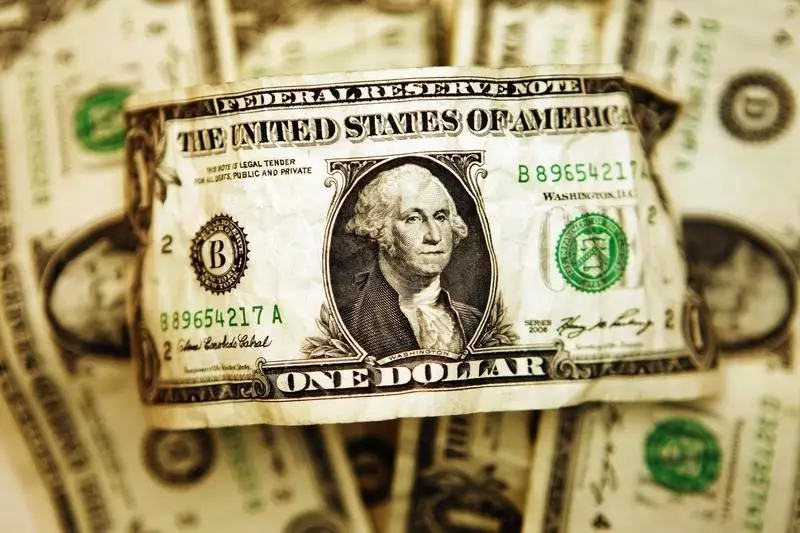Market Dynamics: Understanding the Fluctuating U.S. Dollar and Global Economic Indicators

The U.S. dollar has recently demonstrated a nuanced performance, showing a slight dip following a surge to a six-week high. As of early Friday, the Dollar Index, which assesses the dollar’s value against a basket of six currencies, fell by 0.1% to 101.667. However, it still records a notable increase of nearly 1.5% over the week, marking its most significant weekly rise since April. This update signals an interesting interplay of factors that have both bolstered and challenged the dollar in recent times.
The strength of the dollar during the week was partly attributable to relatively robust labor market indicators, including data on job openings, private payroll numbers through ADP, and weekly claims for unemployment benefits. Moreover, the dollar’s status as a safe-haven asset amid escalating geopolitical tensions in the Middle East has also played a critical role in sustaining its strength, as investors gravitate towards the perceived safety of the U.S. currency in uncertain times.
As attention shifts towards the forthcoming September nonfarm payrolls report, market participants are keenly monitoring this data, anticipating its implications for future Federal Reserve policy regarding interest rates. Predictions suggest that job growth remained steady in the final month of the third quarter, with estimates suggesting payroll figures may rise by approximately 147,000 and the unemployment rate holding steady at 4.2%. However, forecasts from institutions like ING indicate a more conservative outlook, projecting a rise of just 115,000 jobs and a potential increase in the unemployment rate to 4.3%.
Such predictions highlight the ongoing uncertainty surrounding the economic outlook. With Federal Reserve officials particularly attentive to employment trends when making monetary policy decisions, this upcoming data could be instrumental in shaping expectations regarding interest rate adjustments in the near future. Analysts from ING have remarked that these figures are unlikely to alter the overall narrative about the Fed’s potential move to decrease rates by 25 basis points in the next meeting. Still, any softer-than-expected jobs report could lead to a correction in the dollar’s current strength.
Meanwhile, the euro has faced challenges that have affected its value against the dollar. Following reports of cooling inflation and increasing concerns regarding the economic recovery in the eurozone, the EUR/USD pair has experienced a decline, falling to 1.1027—a drop of more than 1% this week. The European Central Bank’s recent moves toward interest rate cuts, combined with the dovish signals from policymakers like Isabel Schnabel, indicate an evolving monetary landscape that is less conducive for the euro.
Despite some positive signals, such as growth in French industrial production, the overall economic indicators suggest that the eurozone’s recovery is still fragile. Analysts predict that EUR/USD could struggle to maintain its ground unless there are significant changes to the economic narrative. With a critical support level at 1.1000, a breach below this point could accelerate downward pressure on the euro.
In contrast, the British pound has seen a modest rebound, rising 0.2% to 1.3154 after a notable drop the previous day. The Bank of England’s stance on potentially aggressive rate cuts has fueled market speculation, especially as inflationary pressures appear to be easing. Despite recent fluctuations, the pound has shown resilience, bolstered by expectations that the Bank of England may maintain higher interest rates compared to its U.S. counterpart, resulting in an overall gain exceeding 3% this year.
On the other hand, the Japanese yen remains mired in uncertainty over the Bank of Japan’s monetary policies. The USD/JPY pair decreased by 0.4% to 146.28, following a peak of 147.25 the day before, as traders grapple with the complexities of Japanese monetary adjustments.
The dynamics surrounding the U.S. dollar, euro, and other currencies illustrate a broader narrative of interconnected economic forces at play globally. Geopolitical tensions, labor market indicators, and central bank policies are shaping investor sentiment and affecting currency valuations. As analysts and traders sift through an evolving landscape of economic signals, the ability to remain attuned to market shifts will be paramount as they navigate the uncertainties ahead. As the economic climate continues to unfold, each currency will need to contend with its unique challenges while responding to broader global trends.





